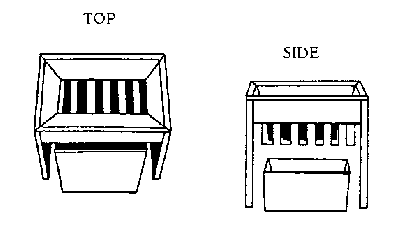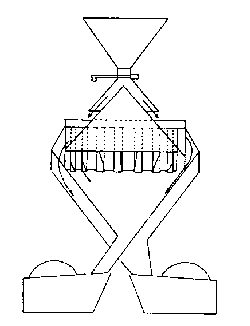MPM: II. Apparatus for Macroanalytical Methods
Macroanalytical Procedures Manual (MPM) Main Page
Some pieces of apparatus and their application are very closely associated with macroanalytical methods. This chapter describes some of the apparatus of special significance to macroanalytical procedures contained in this manual. Unless otherwise noted, these items of apparatus are available through most scientific supply houses.
When following the procedures outlined in this Manual, the analyst should consider the general points noted below:
- The use of polyethylene or spun-metal non-polished beakers, funnels, and containers should be avoided, as insect fragments and rodent hairs may adhere to apparatus made of these materials.
- Glassware should be heat-resistant and, where possible, of heavy wall construction.
- Glass slides should be ordered "pre-cleaned." Despite the label, they should be cleaned prior to first use.
- Glass cover slips should be ordered to meet specifications built into the microscope optical system. Also, two cover slips of two different diameters should be available for double cover slip mounts.
(1) Blender, Patterson-Kelley "Intensifier" Twin-shell
Used to homogenize samples. The blender consists of mounted V-shaped shell blender with an independent 3/4 in. steel shaft with four alternate rows of steel fingers passing horizontally through the blender's shells. The shaft rotates at ca 2000 rpm in the same direction as the shell, which is rotating at ca 25 rpm. (Available from Patterson-Kelley Co., Inc., East Stroudsburg, PA.)
(2) Bolting Cloth
A silk cloth used to filter extraneous material. The cloth is woven to provide a mesh of standard sized openings. The number of the silk specifies the number of openings per linear inch in the mesh. "X", "XX", or "XXX" after the number refers to the thickness of thread from which the cloth is woven. Since both the number and the "X" rating affect the size of the openings in the bolting cloth, recommendations should be followed exactly. (Available from Tetko, Inc., 420 Saw Mill River Rd., Elmsford, NY 10523 and H.R. Williams Mill Supply Co., 208 West 19th St., Kansas City, MO 64108.)
Boil the bolting cloth before cutting into disks to prevent shrinkage. Cut circles 85 mm or larger. To aid in analysis, mark bolting cloth disks either permanently with India ink lines, set 5-7 mm apart, or temporarily with a line-marking ring as described in (6) below.
Polyethylene cloth is also available from Tetko. It is much cheaper than silk bolting cloth, does not have to be boiled for sizing, and can be dyed with certain dyes suitable for plastic fabrics.
(3) Filter Paper
For macro or micro examination, use rapid acting paper, ruled with permanent inks, 5 mm apart (S&S #8 ruled or equivalent). For heavy filth or ashing, use fast, ashless filter paper (Whatman 41 Ashless or equivalent).
(4) Funnels
Several types are useful in macroanalytical procedures.
-
The Hirsch funnel is used for filtration with suction. Use the funnel with filter papers or bolting cloth cupped up on the sides to eliminate loss of solids. Use rapid filter paper for filtration. Bolting cloth or screen (wire, fiberglass, or plastic) should be placed between the perforated funnel plate and filter paper to accelerate filtration and more uniformly distribute the solids. Changing the vacuum, breaking up clumps, and washing down the sides of the paper will also facilitate more uniform distribution of the filtrate. For the Hirsch porcelain funnel, which has an approximate top diameter of 94 mm and plate diameter of 56 mm, use rapid paper, 9 cm in diameter or S&S #8, 7.5 cm.
-
For transferring the product to a trap flask, a 6-10 in. stainless steel or glass funnel with an opening or stem of 5/8 to 1 in. is required.
-
For other purposes, standard glass or stainless steel powder funnels are available.
(5) Samplers
Samplers are used in representative sampling of free-flowing products such as grains. The two samplers described here are gravity mechanical dividers, which are used to divide grain samples into two equal representative portions.
-
Jones Riffle Sampler (Figure II-1)
Jones Riffle Sampler
-- The Jones sampler consists of a hopper that opens to numerous chutes which discharge alternately on opposite sides of the apparatus. Material poured into the hopper is thus directed in approximately equal portions to the two trays positioned below the chutes. The two resulting subsamples are each representative of the original sample. This sampler has been used with good results for many years in FDA field sampling applications. It is available in a variety of chute and hopper sizes from Humboldt Mfg. Co., 7300 W. Agatite Ave., Chicago IL 60656, or the Seedburo Equipment Co., 1022 W. Jackson Blvd., Chicago, IL 60607.
-
Boerner Divider (Figure II-2)
Boerner Divider
-- The Boerner divider employs a conical design to perform the same function as the Jones riffle sampler. The material flows from a funnel-like hopper down the sides of a cone, the tip of which is directly below the center of the hopper opening. A series of channels around the periphery of the cone direct the material into one of two collecting bins. The direction of flow of the channels alternates around the edge of the cone so that every other channel directs the flow into the same collecting bin. The Boerner divider is a highly accurate device for sample division and is standard equipment in Federal, state and local grain inspection offices. It is available from the Seedburo Equipment Company, Chicago, IL.
(6) Line-Marking Ring
Used to make a counting grid on prepared filter papers or bolting cloth. Consists of a steel or plastic ring (made to fit inside petri dishes and over filter papers) strung with nylon line. Lines are set 5 or 7 mm apart with small holes or slits in the ring to hold lines in place.
(7) Magnifying Desk Lamp
For use in macroscopic examinations. The device consists of a low power (3-5X) single lens magnifier encased by a fluorescent ring lamp on a flexible arm. It permits both hands to be free to manipulate sample material.
(8) Microscopes
Used to magnify samples to enhance classification of defects. Two basic units are required:
-
Stereomicroscope -- Minimum specifications call for: inclined binocular body, with adjustable interpupillary distance, over sliding or revolving, parfocal, achromatic objectives, with a geared prism housing, mounted on a base and capable of illumination by transmitted or reflected light. Eyepieces of 10, 15, or 20X magnification may be paired with objectives ranging from 0.6 to 7.5X. The microscope should be flexible for adaptation to other applications and stable for possible photomicrography. Protective cover is required. Eyepiece micrometer and hand rests are recommended.
-
Compound Microscope -- Minimum specifications: inclined binocular body, with adjustable interpupillary distance, over revolving planachromatic objectives, with a geared prism housing, mounted on a base with built-in illuminator and a centerable iris diaphragm/condenser assembly (Achromatic-aplanatic, N.A. 1.40 or equivalent). Eyepieces of 10, 15, or 20X magnification may be paired with lower objectives of 10X, 40X, or 100X. A mechanical stage is required and a color-correcting blue filter is needed. The microscope should be flexible for adaptation to other applications and stable for possible photomicrography. Protective cover is required.
(9) Petri dishes
Used to hold filter papers, bolting cloths, etc., for microscopic examination. Disposable 100 x 15 mm plastic dishes may be used for most applications.
(10) Sieves
Sieve designations, unless otherwise specified, are those described in Federal Specifications RR-S-366e, November 9, 1973 (available from General Services Administration). Sieves of No. 100 or finer should be "plain-weave" stainless steel, since twill weave allows more filaments to pass through. The weave can be seen at 30X magnification.
The International Standard sieve designations and their corresponding U.S. Standard sieve sizes are given in Table II-1. Stainless steel or brass frames in standard heights and diameter are available.
(11) Jeweler's Forceps
Used to manipulate delicate specimens.
(12) Ocular Loupe
Used to provide low-power magnification. Also called a jeweler's eyepiece.
| Sieve Designation | Nominal Sieve Opening, Inches |
Nominal Wire Diameter, mm |
|
|---|---|---|---|
| International Standarda (ISO) |
U.S.A. Standard | ||
| 12.5 mmb | 1/2 in.b | 0.500 | 2.67 |
| 11.2 mm | 7/16 in. | 0.438 | 2.45 |
| 9.5 mm | 3/8 in. | 0.375 | 2.27 |
| 8.0 mm | 5/16 in. | 0.312 | 2.07 |
| 6.7 mm | .265 in. | 0.265 | 1.87 |
| 6.3 mmb | 1/4 in.b | 0.250 | 1.82 |
| 5.6 mm | No. 3 1/2 | 0.223 | 1.68 |
| 4.75 mm | No. 4 | 0.187 | 1.54 |
| 4.00 mm | No. 5 | 0.157 | 1.37 |
| 3.35 mm | No. 6 | 0.132 | 1.23 |
| 2.80 mm | No. 7 | 0.111 | 1.10 |
| 2.38 mm | No. 8 | 0.0937 | 1.00 |
| 2.00 mm | No. 10 | 0.0787 | 0.900 |
| 1.70 mm | No. 12 | 0.0661 | 0.810 |
| 1.40 mm | No. 14 | 0.0555 | 0.725 |
| 1.18 mm | No. 16 | 0.0469 | 0.650 |
| 1.00 mm | No. 18 | 0.0394 | 0.580 |
| 850 µmc | No. 20 | 0.0331 | 0.510 |
| 710 µm | No. 25 | 0.0278 | 0.450 |
| 600 µm | No. 30 | 0.0234 | 0.390 |
| 500 µm | No. 35 | 0.0197 | 0.340 |
| 425 µm | No. 40 | 0.0165 | 0.290 |
| 355 µm | No. 45 | 0.0139 | 0.247 |
| 300 µm | No. 50 | 0.0117 | 0.215 |
| 250 µm | No. 60 | 0.0098 | 0.180 |
| 212 µm | No. 70 | 0.0083 | 0.152 |
| 180 µm | No. 80 | 0.0070 | 0.131 |
| 150 µm | No. 100 | 0.0059 | 0.110 |
| 125 µm | No. 120 | 0.0049 | 0.091 |
| 106 µm | No. 140 | 0.0041 | 0.076 |
| 90 µm | No. 170 | 0.0035 | 0.064 |
| 75 µm | No. 200 | 0.0029 | 0.053 |
| 63 µm | No. 230 | 0.0025 | 0.044 |
| 53 µm | No. 270 | 0.0021 | 0.037 |
- These standard designations correspond to the values for test sieve aperatures recommended by the International Organization for Standardization, Geneva, Switzerland.
- These sieves are not in the standard series but they have been included because they are in common usage.
- 1000 µm=1mm


